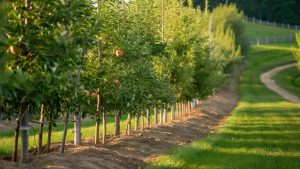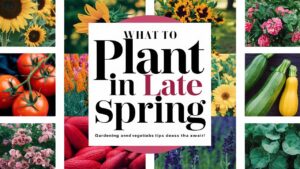In this guide, we’ll help you choose the best fertilizer for roses, ensuring your garden flourishes with color and life.
Fertilizer For Roses
| Image | Name | Rating | Shop |
|---|---|---|---|
 | RoseMAX Booster |  | |
 | BioAdvanced Rose Care |  | |
 | Rose-tone |  |
RoseMAX Booster
For those looking to give their roses a boost, Great Big Roses – Soil and Rose Fertilizer Booster is a top choice. This concentrate makes 80 gallons of liquid fertilizer and can be used on a variety of flowers as well as rose bushes.
The product works by infusing soil with beneficial ingredients that improve structure and optimize conditions for plant growth. Its proprietary compost extract also boosts the effects of fertilizer, making it work better within the root zone of the rose bush. With over 70 chelated trace minerals and seaweed added in, this all-in-one solution is perfect for those who want a hassle-free way to get their roses looking great without digging or tilling. Its earth-friendly ingredients, registered under the National Organic Program, also make it a great choice for environmentally conscious gardeners.
BioAdvanced Rose Care
BioAdvanced All-In-One Rose and Flower Care Fertilizer is a decent option to consider for your roses. This fertilizer comes in a 64 oz concentrate that can be easily mixed and applied around the base of the plants.
With features like insect killer, disease control, and rainproof protection lasting up to six weeks, this product seems to offer a one-stop solution for rose care. It’s also relatively straightforward to use, which may appeal to those who want an effortless fertilization process without worrying about complicated application methods.
Rose-tone
This fertilizer is suitable for use on various types of roses, including hybrid teas and shrub varieties like knockouts. It can also be applied to flowering plants such as clematis and viburnum.
Rose-tone organic fertilizer has a 4-3-2 NPK analysis, with added calcium and Bio-tone formula, making it an effective choice for promoting green growth and abundant blooms. As an organic product, it does not contain any sludge or toxic ingredients, making it safe to use in gardens that adhere to organic gardening practices. The fertilizer comes in a 4 lb bag and can be purchased as a pack of two. It’s important to apply this fertilizer monthly during the growing season (usually May through September) by sprinkling it around the base of the plant and watering thoroughly.
Rose & Flower Mix Fertilizer Blend
Down To Earth All Natural Fertilizers Organic Rose & Flower Mix 4-8-4 is a good option to consider for fertilizing roses. It’s an all natural, organic fertilizer that contains a blend of ingredients like fish bone meal, blood meal, alfalfa meal, seabird guano, and others to provide nitrogen, phosphorus, potassium, and trace elements.
This particular product is designed to promote vigorous growth and sensational flowers in roses and other flowering plants. It’s listed by the Organic Materials Review Institute (OMRI) for use in organic production, making it a suitable choice for gardeners looking for an organic fertilizer option. The 5 lb bag should last throughout the growing season with regular application.
Farmers Secret Rose Food
Roses can be a bit finicky, but with the right fertilizer they’ll thrive. The Farmer’s Secret Rose Booster Fertilizer is one product that stands out from the rest. Its super concentrated formula ensures you won’t need to use much to see results.
This fertilizer has been specifically formulated for all types of roses and works throughout their life cycle, encouraging healthy growth and vibrant blooms. Simply dilute two teaspoons of the product into a gallon of water and apply it weekly during the growing season. The result will be beautiful roses with minimal effort. It’s no wonder Farmer’s Secret is trusted by farmers to provide top-notch results for their gardens – now you can experience the same in your own yard.
Blooming Plant Food
The Miracle-Gro Shake ‘N Feed Rose & Bloom Plant Food is a top-notch choice for rose enthusiasts. This product uses natural ingredients that really get the job done by fostering healthy microbial activity in the soil, which in turn gives your roses a vibrant boost in terms of blooms and vibrant colors.
Whether you’re working with new or established roses, this formula delivers consistent results over time – lasting up to 3 whole months! This convenient plant food is easy to use on all types of flowering plants, both those planted directly into the ground and those grown in containers. It really does take the guesswork out of feeding your roses, giving you more peace of mind while watching them thrive.
Rose Bloom Feeder
The Scotts Rose & Bloom Continuous Release Plant Food is a good product to consider if you want to promote blooming in roses and other flowering plants. This plant food works by providing steady feeding that can last up to two months.
It’s easy to apply, simply sprinkle it directly onto the soil around your roses or other flowers, and it won’t burn them when used as directed.
Burpee Organic Rose + Bloom Granular Plant Food
Burpee’s Organic Bloom Granular All-Natural Food for Roses and Flower Plants is a solid choice if you’re looking for a fertilizer option that won’t harm your plants or the environment. The OMRI-listed formula provides an immediate boost of nutrients, followed by slow-release feeding that lasts up to 3 months.
This granular plant food is ideal for container gardens, beds, and bushes, and can be easily spread with its fine consistency. Just make sure to wear garden gloves when handling it and apply as directed – every two months during the growing season should do the trick. With its ability to promote spectacular blooms, more color, and strong root development, this fertilizer is a great option for rose growers looking to take their plants to the next level.
How To Choose The Best Fertilizer For Roses
Roses, with their lush blooms and intoxicating fragrance, symbolize beauty and passion. For many gardeners, cultivating these stunning flowers isn’t just a hobby; it’s a labor of love. However, achieving the vibrant, healthy roses of your dreams doesn’t solely rely on careful pruning or selecting the right varieties. One of the most critical factors that contribute to the growth and blooming of roses is the fertilizer you choose.
Understanding Rose Nutritional Needs
Before we discuss fertilizers, it’s crucial to understand the specific nutritional requirements of roses. Roses are heavy feeders, meaning they require a rich supply of nutrients to thrive. The main nutrients that roses need include:
Nitrogen (N): Essential for leafy growth and overall plant health. It encourages the development of chlorophyll, which is vital for photosynthesis.
Phosphorus (P): Important for root development and flower production. This nutrient supports the establishment of strong roots and enhances blooming.
Potassium (K): Enhances overall plant vigor and stress resistance. It plays a significant role in the regulation of water and nutrient uptake.
In addition to these primary nutrients, roses also benefit from secondary nutrients like calcium (Ca), magnesium (Mg), and sulfur (S), as well as trace elements such as iron, manganese, and boron. A balanced approach to fertilizing will ensure your roses have the right nutrients in appropriate amounts.
Types of Fertilizers Available
Once you understand the nutritional needs of roses, the next step is to familiarize yourself with the various types of fertilizers available. There are several categories of fertilizers, and each type has its own unique advantages.
1. Granular Fertilizers
Granular fertilizers are a popular choice among many gardeners. These fertilizers come in solid form and can be applied directly to the soil. They provide a slow and steady release of nutrients over time, reducing the risk of nutrient leaching with frequent watering or rain.
Advantages:
Slow-release: Provides nutrients gradually, reducing the frequency of application.
Easy application: Just sprinkle around the base of the plant.
Long-lasting: Nutrients are available for weeks or even months.
2. Liquid Fertilizers
Liquid fertilizers, or soluble fertilizers, dissolve in water and can be applied as a foliar spray or soil drench. They provide an immediate nutrient boost and are excellent for quickly addressing deficiencies.
Advantages:
Fast-acting: Nutrients are absorbed quickly by plants.
Customizable: Easier to adjust nutrient concentrations according to plant needs.
Ideal for container roses: Allow for precise nutrient management in pots.
3. Organic Fertilizers
Organic fertilizers are derived from natural sources, such as manure, compost, or bone meal. They not only provide essential nutrients but also improve soil structure and health over time.
Advantages:
Improves soil health: Builds beneficial microbial activity in the soil.
Eco-friendly: Reduces chemical inputs and promotes sustainability.
Slow-release: Provides a steady supply of nutrients as they break down.
4. Synthetic Fertilizers
Synthetic fertilizers are chemically manufactured products that can provide a tailored nutrient mix to suit specific plant growth stages. They often have higher nutrient concentrations than organic alternatives.
Advantages:
Highly concentrated: Deliver precise nutrient ratios for targeted growth.
Instant results: Quickly address nutrient deficiencies.
Wider availability: Easily found in garden centers and stores.
Analyzing Fertilizer Labels
When selecting a fertilizer for your roses, don’t overlook the importance of reading the label. Fertilizer labels provide essential information about nutrient composition, and understanding this can help you make an informed decision.
1. N-P-K Ratio
The N-P-K ratio on the label signifies the percentages of nitrogen (N), phosphorus (P), and potassium (K) in the fertilizer. For roses, a balanced N-P-K ratio is usually recommended, often represented as 10-10-10, 5-10-5, or 4-12-4, depending on the growth stage.
10-10-10: A balanced formula suitable for general use.
5-10-5: Higher phosphorus supports flower production, especially during blooming.
4-12-4: A good ratio for encouraging strong root development and vibrant blooms.
2. Slow-Release vs. Quick-Release
Assess whether the fertilizer is slow-release or quick-release. Slow-release fertilizers provide nutrients gradually, making them ideal for long-term feeding. Quick-release fertilizers offer immediate results but may require more frequent applications.
3. Additional Micronutrients
Sometimes, fertilizers will also list additional micronutrients, such as iron, manganese, or magnesium. Consider choosing a fertilizer that includes these essential elements, as they are critical for robust rose health, particularly in soil with nutrient deficiencies.
Timing Your Fertilization
Timing is just as important as the type of fertilizer you choose. Understanding the growth cycle of your roses can guide you on when to fertilize for maximum effectiveness.
1. Spring Awakening
As roses emerge from dormancy in spring, they will require an early feeding. Fertilizing in early spring (around March to April) encourages vigorous growth, helping to produce new leaves and stems in preparation for blooming.
2. Pre-Bloom Fertilization
A second application before the initial bloom (typically in late spring) will boost flower production. This is particularly important for hybrid roses that tend to flower in cycles. At this stage, a fertilizer high in phosphorus (the middle number in the N-P-K ratio) is beneficial.
3. Late Summer Feeding
For continuous blooms throughout the growing season, a late summer feeding (around July to early August) may be necessary. This application supports the development of late summer and fall blooms. However, be cautious not to fertilize too late in the season, as it can encourage new growth that may not harden off before winter.
Testing Your Soil
Before you commit to a fertilizer, conducting a soil test may prove highly beneficial. A soil test informs you about the nutrient composition, pH levels, and overall health of your garden’s soil. Most local extension services or gardening centers offer soil testing kits.
Benefits of Soil Testing
Identifies nutrient deficiencies: Understand what nutrients your soil is lacking.
Informs pH levels: Roses prefer slightly acidic soil (pH 6.0 to 6.8). Amendments may be needed if the pH is too high or too low.
Tailored fertilization: Allows for precise alterations based on specific needs rather than guesswork.
Organic vs. Synthetic: Which is Best for Roses?
The debate between organic and synthetic fertilizers continues among gardeners, each having valid points. Your choice will depend on your gardening philosophy, the health of your soil, and how much time you want to invest in gardening practices.
Organic Fertilizers
Using organic fertilizers has many advantages, particularly in terms of soil health. They generally promote sustainable gardening practices, facilitating a natural ecosystem. However, they may require more frequent applications as they often provide lower nutrient concentrations.
Synthetic Fertilizers
Synthetic fertilizers can offer immediate results and targeted nutrient management, making them appealing to many gardeners. However, some may argue that frequent use can lead to nutrient runoff, negatively impacting the environment. Furthermore, synthetic nutrients do not improve soil structure and health as organically derived fertilizers do.
For rose care, consider your personal goals: if you desire to encourage a healthy natural ecosystem in your garden, organic options may be best. On the other hand, if you strive for stunning blooms and rapid results, synthetic fertilizers might be more aligned with your intent.
Common Mistakes to Avoid
Navigating the world of fertilizers can be daunting, especially if you’re new to rose gardening. Here are a few common pitfalls to avoid while choosing fertilizer:
Over-fertilizing: Many gardeners mistakenly think that more is better. Over-fertilization can harm roses, leading to excessive foliage growth at the expense of blooms. Follow the package instructions and err on the side of caution.
Ignoring Soil Conditions: Always take into account your soil’s condition and structure before selecting a fertilizer. Fertilizing in compacted or poorly draining soils can lead to fertilizer burn or inhibit root development.
Failing to Rotate: Using the same fertilizer year after year can lead to nutrient imbalances in the soil. Consider rotating fertilizers to ensure a more rounded supply of nutrients.
Neglecting Watering: Fertilizers should not be applied to dry soil. Always ensure that your roses are well-watered before and after fertilization, as water aids in nutrient absorption.
Skipping Seasonal Adjustments: Adjust your fertilization strategy based on the roses’ growth stage as discussed previously. What works in spring might not be suitable for late summer.
Responsible Fertilizer Application
Regardless of the fertilizer type you choose, consider these best practices for responsible application:
Application Rates: Always apply fertilizers at the recommended rates. Using a calibrated spreader, if applicable, can ensure even distribution.
Timing: As mentioned earlier, an appropriate schedule for fertilization based on growth stages can significantly affect results.
Uniform Distribution: Spread fertilizer evenly around the plants. Try to keep it a few inches away from the base of the plant to avoid root burn.
Watering After Application: Follow up any fertilization with thorough watering to ensure the nutrients penetrate the soil and reach the root system.
Conclusion
Choosing the best fertilizer for your roses entails a blend of understanding your plants’ nutritional needs, knowing the types of available fertilizers, analyzing labels, timing your applications, and considering your soil’s unique characteristics. Whether you opt for organic or synthetic options, the right fertilizer should encourage luscious growth and stunning blooms, allowing your garden to burst alive with the joy and beauty that roses embody.










